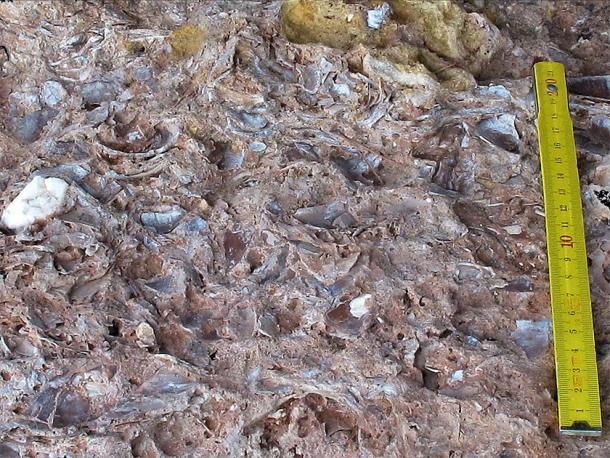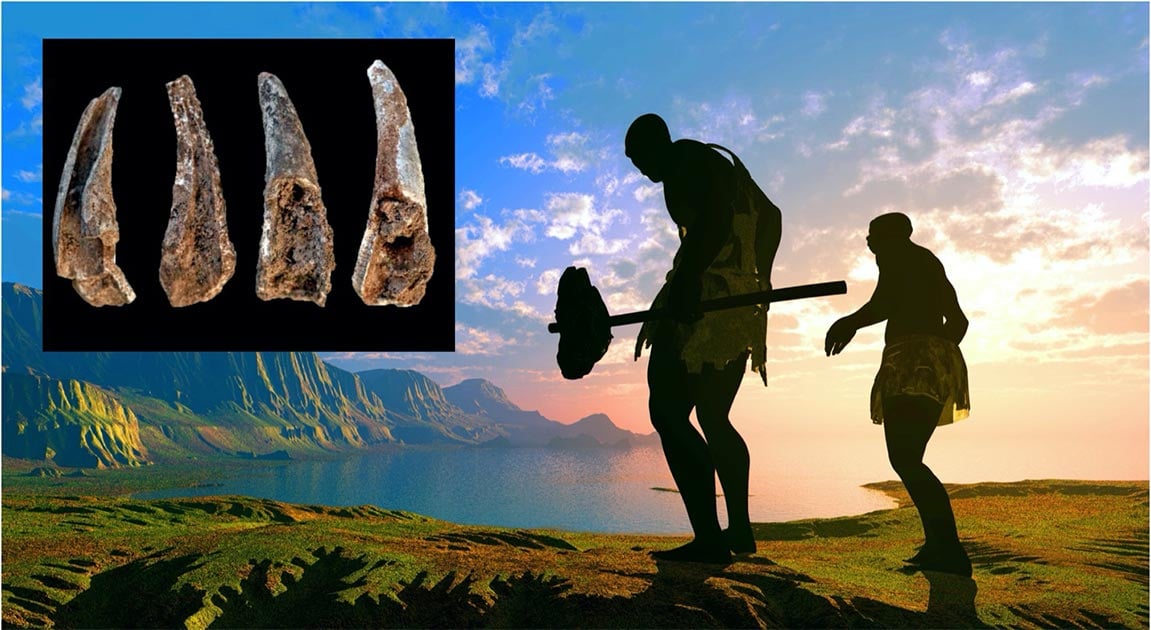80,000 Years Ago Neanderthals Supercharged Their Brains On Acid
Scientists have determined Neanderthals had a fish and seafood diet as early as 80,000 years ago and benefited from the raised cognitive powers that up to now have only been attributed to Homo sapiens.
The first scientifically verified evidence of Neanderthals eating marine creatures has been found in the cave of Figueira Brava in Portugal, located 30 kilometers (18.6 miles) south of Lisbon on the slopes of the Serra da Arrábida.
Neanderthals Had a Fish and Seafood Diet
A multidisciplinary international team of researchers, with the participation of the University of Göttingen, determined our distant Neanderthal cousins ate mussels, fish and other marine life. This was established after Dr. Dirk Hoffmann’s team at the Göttingen Isotope Geology Department dated “flowstone layers,” which are calcite deposits caused by dripping water that form stalagmite like structures.

View of mussel fossil bed found at Figueira Brava excavation site, showing evidence of the Neanderthals’ seafood diet. (João Zilhão / University of Göttingen)
The new study was published in the journal Science by the first author of the study, Professor João Zilhão from the University of Barcelona, which negates the traditional idea that fish and seafoods were the reserve of Homo sapiens (anatomically modern humans) in Africa.
According to an article in Science Daily, the scientists applied an analysis method known as “uranium-thorium,” or “thorium-230 dating, which is a radiometric dating technique that since the 1970s has been used to age calcium carbonate materials. The excavation layers in Figueira Brava were found to be between “86,000 and 106,000 years old,” when Neanderthals began settling in Europe.
Ancient Acids Raised Cognitive Prowess
Today, Portugal’s cave of Figueira Brava is located directly on the waterfront, but 80,000 years ago it was up to 2 kilometers (1.2 miles) from the coast. The research team found that Neanderthals living in the cave “routinely harvested” mussels and other crustaceans, fish, waterfowl and marine mammals, such as dolphins and seals. Fish, and particularly shellfish are rich in omega-3 fatty acids and other substances that promote the development of the nervous system and brain tissue.

View of the Figueira Brava cave with its three entrances on the waterfront. (João Zilhão / University of Barcelona)
Packed with calcium, iron, magnesium, phosphorous, potassium, copper and selenium, only a three ounce (84 grams) serving of scallops contains 18% of the recommended daily intake for both vitamin B12 and zinc, as well as over 300 mg of omega-3 fatty acids.
According to Healthline one recent scientific study found that babies born to women who had low vitamin B12 levels during pregnancy had “slowed brain function nine years later” and that these children took over “20 seconds longer to complete cognitive tests than those of women with adequate B12 levels.” Putting these nutritional facts in historical context, a 20 second lag when being chased along a cliff by a mammoth who had turned on the hunters, or being attacked by a wolf, would make ‘all’ the difference between life and death.

Cracked-open and burnt fragments of pincers of the edible crab (cancer pagurus) found at the Figueira Brava cave, showing evidence of the Neanderthals’ seafood diet. (João Zilhão / University of Barcelona)
The Tide Finally Turns for the “Moronic” Neanderthals
Until now, according to co-author Dirk Hoffmann of the University of Gottingen in Germany, it has always been suspected that fish and shellfish consumption increased the cognitive abilities of humans ( Homo sapiens) and this explained the early appearance of symbolic artifacts such as “body painting with ochre, the use of ornaments or the decoration of containers made of ostrich eggs with geometric motifs,” which contributed to the emergence of more organized and complex societies of modern humans.
However, the new evidence gathered from Figueira Brava means that if the habitual consumption of marine life played an important role in the development of cognitive abilities, then this is equally as true for Neanderthal populations as it is for anatomically modern humans. Put another way, “if this common consumption of marine resources played an important role in the development of cognitive skills, it did so on the entire humanity, including Neanderthals, and not only the African population that spread later,” said Dr. Zilhão.
- Top Ten Myths about Neanderthals
- The Widespread Appearance of Neanderthal DNA: Africans Have It Too
- 'Flower Burial' Indicates Neanderthals Had Death Rites
When Subjective Evidence is Cemented
This study proves ancient Neanderthals shared human’s increased cognitive ability, which would also have boosted their ability for abstract thought, and this jigsaws perfectly with increasing subjective evidence that Neanderthals had caught and used shellfish and applied artistic thinking.

Stone tools found at the Figueira Brava cave. (João Zilhão / University of Barcelona)
For example, decorated seashells, rock art and cave paintings were discovered in three caves on the Iberian Peninsula in Spain dating to 65,000 years ago by the same research team, and according to previous Ancient Origins articles, recent evidence suggests Neanderthals suffered “surfer’s ear” and may have dived to collect shells for use as tools and in crafts. Now we know they did.
Top image: Main: Representation of Neanderthals going fishing. (Kovalenko I / Adobe stock). Inset: Cracked-open and burnt fragments of pincers of the edible crab (cancer pagurus) found at the Figueira Brava cave, showing evidence of the Neanderthals’ seafood diet. (João Zilhão / University of Barcelona)
By Ashley Cowie




















Comments
The chemical, which today is termed LSD has been around for ever.
Albert Hoffman extracted LSD from the Purple Morning Glory seeds in order to be able to be able to patent it and make millions for his (big) pharmaceutical brothers/masters which I believe was at the time, Bayer.
Almost all medications today were and are still extracted from plants or natural fungal growths. In order to patent, preventing others which may be interested. 'They' have extracted that which they call the active ingredient, throwing away all the other synergistic ingredients, rendering their medications toxic and dangerous.
The title of this article is sensationalism at its worst. It’s totally ridiculous to think that Neanderthals used ‘acid’ (slang for LSD) to increase their brain power. LSD wasn’t even invented (by the CIA) until the 1960’s.
Admittedly the article is good. It’s too bad the title had txo be so misleading and false.
It is kind of a let down when you are click-baited into thinking there is evidence that Neanderthals dropped acid, kind of like one of those ancient ancestors who co-founded the psychedelic band Pink Floyd who admitted he never used until 2008. No wonder he likes to dress up like a Nazi.
The title of this article is totally misleading as it has nothing to do with Acid.
Click bait.
It is false to assume that intelligence is enhanced by eating animals. This is propaganda similar to the advert jingle "Sugar gives you go".